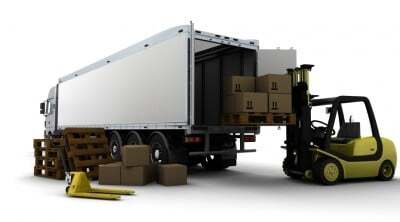In today’s globalized economy, the efficient and timely movement of goods is crucial to the success of businesses in nearly any industry. Trucking freight, whether it be raw materials, finished products or equipment, requires careful planning and execution to ensure that it arrives at its destination on time and in good condition. But how does freight shipping work? And how can your business get started?
We’ll quickly explain the ins and outs of shipping by freight, from understanding freight rates to creating a Bill of Lading (BOL) and more. We’ll explain how to ship freight in five crucial steps so you’ll be equipped to make informed decisions about moving your goods — and ensuring they reach their destination on time and within budget.
Article Contents:
What Is Freight?
While the term can mean different things to different entities, freight almost always refers to goods that are collectively much bigger and heavier than your average parcel. While there are exceptions (like a single substantial item requiring special equipment), freight typically refers to a lot of stuff that needs to get from point A to point B efficiently and securely. From raw materials to finished products, freight shipments are the backbone of global trade. Understanding how to ship freight is essential for any business looking to compete in today’s economy.
What Is Freight Shipping?
Picture this: a massive cargo ship docking at a bustling port, filled to the brim with containers stacked high with goods from all corners of the world. That’s freight shipping – the transportation of large quantities of products in bulk domestically or across the globe via air, land or sea.
When shipping by freight, all the goods are loaded onto pallets or large, sturdy cargo containers and moved using one or more modes of transportation.
Methods of Shipping Freight
If you’ve ever ordered a product online or received a package from overseas, chances are it was shipped using some form of freight shipping. There are several methods of shipping freight, each with advantages and disadvantages, but we’ll focus on just two of the most commonly used methods.
FTL Freight Shipping
Full Truckload (FTL) shipping is a popular method of shipping freight used by businesses worldwide. It involves transporting goods in a single truck (via road or rail), with the entire load belonging to a single customer. Since the freight shipment is not shared with other customers, it arrives at its destination quickly and safely.
One of the top benefits of FTL freight shipping services is its efficiency, as it is a direct, non-stop shipment that doesn’t require any additional handling. Most FTL containers can transport anywhere from 24 to 26 pallets. For businesses that need to transport large quantities of goods over long distances, FTL shipping is an ideal choice that provides both cost savings and peace of mind.
LTL Freight Shipping
Less Than Truckload (LTL) freight shipping is another popular method businesses use for shipping by freight. Unlike FTL shipping, LTL shipments are typically smaller and consolidated with other shipments to fill the truck. They are generally between 1 and 6 pallets. This can result in cost savings for businesses, as they only pay for the space they need.
Additionally, LTL freight services are more flexible than FTL shipping, as businesses can ship smaller quantities of goods regularly rather than waiting until they have a full truckload. According to industry trends, LTL shipping is becoming more popular due to the rise of e-commerce and the increase in small businesses selling products online. For businesses that need to transport smaller shipments or have more flexible delivery schedules, LTL shipping is an excellent option that provides cost savings and convenience.

How to Ship Freight in 5 Steps
The preparations for shipping freight are much different from shipping a typical parcel. Below are a few key steps you’ll need to consider to know how to ship freight with accuracy and efficiency.
1. Create a Bill of Lading (BOL)
If you’re in the business of shipping by freight, you need to create a Bill of Lading (BOL) to start the entire process. This document is the most important document involved in transporting your shipment. A Bill of Lading is a legally binding contract between you and your carrier, doubling as a document of title.
Your Bill of Lading provides all the necessary information for the driver and carrier to process and invoice each shipment precisely. Without one, the transportation process can quickly turn into a chaotic mess. If you want to keep your freight moving smoothly and your stress levels low, you’ll need to ensure you have a properly filled-out Bill of Lading for each shipment.
2. Prepare Appropriately-Sized Pallets or Containers
Next, you must prepare and consolidate your shipment to ensure ease of movement. Pallets are the most commonly used form when shipping freight, but non-palletized shipments are just as simple and effective.
When selecting a pallet, choosing one made of high-quality wood or plastic weighing between 20 and 70 pounds is essential. You’ll also want to make sure it’s sturdy enough to support the load and big enough to avoid any overhang that could cause damage.
If you’re not using a pallet, you’ll need to prepare your shipping containers, crates or corrugated boxes. Ensure that they’re strong enough to support the weight of your package and that there are no holes or tears that could compromise the contents. If you’re shipping freight with reused containers, remove old barcodes and labels to prevent your package from being shipped to the wrong location. Use dunnage on all sides of the container to keep your items in place and reinforce the edges to protect them from bending. Finally, seal all openings and seams with reinforced tape to keep your package secure during transit.
3. Attach the Necessary Labels
The next crucial step in shipping freight is labeling and documentation. To make sure your pallets or containers are ready for transport, here are some labeling requirements you need to keep in mind:
- For standard freight pallets, it’s essential to have clear and visible labeling with the shipper’s address and telephone number on every side of the pallet. Additionally, don’t forget to include a packing list and the bill of lading.
- If shipping internationally, you must provide a commercial invoice and a certificate of origin. But no worries, most carriers accept these documents electronically.
It’s also important to note that if you’re using Third-Party Logistics (3PL), they may have specific labeling requirements for your freight. Be sure to consult with your partner to ensure your shipment is labeled correctly and meets all requirements.
4. Calculate the Cost of Shipping By Freight
Shipping freight can be costly, and the last thing you want is to be hit with unexpected expenses. So, let’s break down the process of estimating rates of shipping by freight to help you make an informed decision.
First things first, it’s crucial to partner with the right freight provider that meets your specific shipping requirements. You can get a good sense of the cost by requesting a quote from a few carriers offering the services you need.
The quote process is relatively straightforward. You’ll need to provide information about the products you’re shipping, the origin and the destination of your shipment, and any special handling instructions or value-added services you require. With this information, carriers can provide you with an accurate estimate of your freight shipping costs.
5. Follow All Freight Carrier Instructions
Every freight carrier has its own guidelines for preparing for a smooth and hassle-free pickup. For example, some carriers may require pre-authorization for certain types of shipments. So, carefully read the carrier’s instructions to avoid any last-minute surprises.
Don’t rush through the instructions. Take your time to understand what’s required of you, and make a checklist to ensure you’ve covered everything. Doing this will give you the confidence that you’re fully prepared for the pickup, and you’ll be able to avoid any unnecessary delays or issues.
Shipping Freight Is Simple at Freight Rate Central
Now that you know how to ship freight, it’s time to choose your carrier. Enter Freight Rate Central – your ultimate solution for fast, affordable, seamless freight shipping. We offer an extensive range of services for shipping freight, and best of all, you can get free and automated online quotes for all of them.
Whether you’re a big business, small business or private household, we’ve got you covered with thousands of fleets and carriers nationwide. Plus, with Freight Rate Central, you can access every service that’s part of the nationwide commercial shipping network. We’re available 24 hours a day, 365 days a year, so you can ship your freight whenever convenient. And, with our competitive rates, you can rest assured that you’re getting the best value for your money. Request your free quote from Freight Rate Central today.










